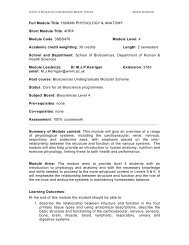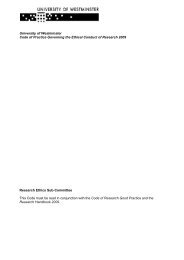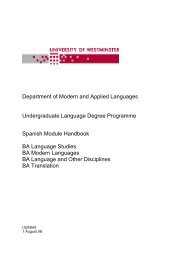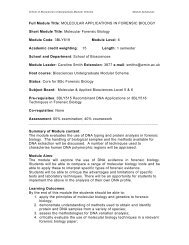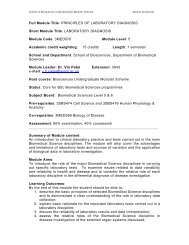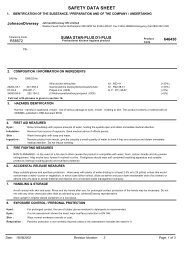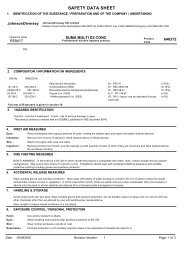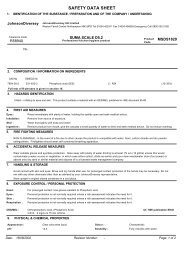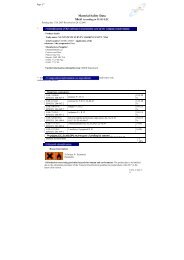CONTENTS 1. Introduction 1.1 Course Outline 1 1.2 Introduction ...
CONTENTS 1. Introduction 1.1 Course Outline 1 1.2 Introduction ...
CONTENTS 1. Introduction 1.1 Course Outline 1 1.2 Introduction ...
Create successful ePaper yourself
Turn your PDF publications into a flip-book with our unique Google optimized e-Paper software.
Light diffusion and partitioning; spread functions, resolution and sharpness.<br />
Spatial frequency: Images as sets of spatial frequencies. Spatial frequency response.<br />
Image noise: causes and simple methods of analysis.<br />
Information: <strong>Introduction</strong> to information as a measurable quantity for an image.<br />
Introductory colour: Simple methods of measurement and specification. RGB.<br />
Mathematics: <strong>Introduction</strong> to Calculus. Rates of change, differentiation. Integration as the reverse of<br />
differentiation. Integration as an area. Methods of differentiation and integration. Trigonometry –<br />
sine and cosine functions.<br />
Statistics: Probability and its distributions. <strong>Introduction</strong> to significance testing.<br />
Teaching and Learning Methods:<br />
Illustrated lectures and workshops (appx 36 hrs). Laboratory work (appx 24 hrs). Seminars and<br />
tutorials (appx 12 hrs).<br />
Assessment Rationale:<br />
The examination will test the students’ ability to define and understand concepts, derive simple<br />
results, describe applications and procedures, and to analyse and conclude on simple case studies.<br />
(Learning outcomes 1,3,5,7 and 8).<br />
Written coursework may consist of an essay, a number of mathematical problems and general<br />
imaging problems requiring a detailed and accurate analysis at the appropriate level, with<br />
justifications and assumptions as necessary. Students are encouraged to consult a range of sources,<br />
and assignments are timed to enable valuable feedback. (Learning outcomes 4,5,7,8).<br />
Practical work is assessed by written reports from assignments. The student must demonstrate an<br />
ability to:<br />
• Understand and interpret an experimental brief and establish the appropriate experimental<br />
design.<br />
• Collect appropriate data in a reliable manner.<br />
• Analyse the data as advised and clearly present the results.<br />
• Present sound discussions and conclusions on the work in the light of expected outcomes.<br />
(Learning outcomes 2, 4, 6 and 9).<br />
The Group Presentation will involve small-group work in the research, interpretation and presentation<br />
of a relevant topic. (Learning outcomes 1 and 9).<br />
Assessment criteria:<br />
The extent to which the student is able to demonstrate an ability to:<br />
• Handle the units involved in the various objective measures.<br />
• Perform set mathematical tasks.<br />
• Use appropriate formulae from input-output theory, spatial frequency response theory and<br />
introductory colour theory to analyse data and interpret findings.<br />
• Interpret the terminology relevant to basic imaging performance.<br />
• Describe, and where appropriate, derive simple relationships between aspects of image<br />
quality and measurable properties.<br />
• Successfully use a variety of imaging processes in an objective manner, including calibration<br />
procedures.<br />
• Plan and carry out experimental investigations, keeping a laboratory notebook.<br />
• Interpret experimental results with due regard for experimental errors, and discuss and<br />
conclude on the findings in the light of other published results or expected outcomes.<br />
• Use reference material as appropriate.<br />
Assessment Methods and Weightings:<br />
Written examination: 40%, Written <strong>Course</strong>work: 20%, Practical work: 40%.<br />
Sources:<br />
Essential reading:<br />
R.E.Jacobson, S.F.Ray, G.G.Attridge and N.R.Axford., The Manual of Photography<br />
Press, Oxford(2000).<br />
L.R.Mustoe and M.D.J.Barry, Foundation Mathematics, Wiley, Chichester(1998).<br />
(9 th ed), Focal<br />
DPI_Hbook 50 ©University of Westminster





